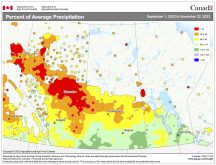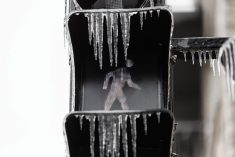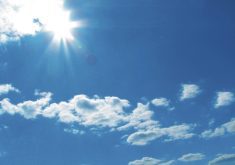CO-OPERATOR CONTRIBUTOR
Last issue we began our look at what s available for the weather enthusiast on your Christmas list, and we started off by looking at several different weather instruments that are available for under $50. This week we ll continue our look, but will bump up our price range. Don t forget to check out www.AmbientWeather.com for probably the most complete list of weather instruments available anywhere.
If we start looking in the $100 range there are several interesting instruments available. In this price range we find the starter packages for complete wireless home weather stations. These stations get better and better each year. While they still can t compare to the high-end home weather stations, for the beginner or youngster out there they are a great place to start. There are several different companies that make weather stations in this price range, with some of the best coming from La Crosse and Oregon Scientific. These home weather stations come with an anemometer (wind-speed and wind direction), rain gauge, outdoor temperature and humidity sensors, indoor temperature and humidity sensors and barometric pressure. These stations are also able to calculate dew point, wind chill and heat index values.
Read Also

Thunderstorms and straight-line winds
Straight-line winds in thunderstorms can cause as much damage as a tornado and are next on our weather school list exploring how and why severe summer weather forms.
Also in the $100 price range, if you are more of a traditionalist, is the starting point of some really good classic and antique weather instruments that feature wood, brass and glass finishes. These weather instruments can measure pretty much anything the computer-based home weather station can, and come in several different styles. The traditional style is the three-dial station that displays temperature, humidity and barometric pressure. In higher-quality instruments, for this price range you can get a single-dial station that usually includes temperature and humidity.
A couple of interest ing weather gadgets at this price range are the portable lightning detector and the portable wind meter. While most portable lightning detectors are much more expensive, there are a couple of fairly simple ones. These fit-in-your-hand devices can detect and warn you of lightning strikes as far as 50 to 60 kilometres away, by indicating lightning using LED lights or having a tone play. As with the portable lightning detector, portable wind meters are fairly expensive, but there are a few available at this price. Kestrel makes a dedicated wind meter in this price range, while Ambient offers a hand-held wind meter that also includes temperature, humidity, dew-point and a compass.
Now it s time to move on to the high-end price range, which for the most part, is between $300 and $1,000. At this price range you can pretty much get the weather station of your dreams. There are several traditional instruments available in this price range. For example, you can get an old-fashioned barograph for about $1,300, but I will leave these types of weather instruments for you to discover if you are really interested. Instead, I am going to concentrate on full-featured weather stations.
Considerations
There are several things you ll need to take into account when you buy a full-featured weather station, and they include accuracy, range, cost, reliability, support, ease of installation, maintainability and computer software. As with most things in life, you get what you pay for, and it s pretty rare that a $300 weather station will outdo a $600 station. There are a lot of different weather stations available in this price range, but the two most popular or common are made by Davis Instruments and Oregon Scientific.
The station offered by Oregon Scientific is the WMR200 and sells for about $300. While this system offers the full range of instruments it does score low in its ability to accurately measure barometric pressure and rainfall. While it does have the option for ultraviolet (UV) detection it does not have the ability to record solar radiation. Overall the WMR200 scored an OK result according to Ambient Weather. Looking around at the different home-based weather stations sharing their data online, I only found a couple of Oregon Scientific stations.
By far the most popular and overall the most reliable home-based weather stations are made by Davis Instruments. Davis has come close to capturing the home-based market by offering easy-to-install, reliable and reasonably cost-effective weather stations for over 15 years. The two most popular stations offered by Davis are the Vantage Pro/Pro2 and the Vantage Vue weather stations. The main difference between these two stations is that the Vantage Vue was designed with all the weather instruments fully integrated into one easy-to-install package, perfect for the home user. The Vantage Pro/Pro2 has more options available for it, including where to install the different sensors and the ability to add additional sensors such as soil moisture and leaf wetness. Both stations are highly reliable and will give you years of service. If you do plan on downloading your information to a computer, you ll need to get the additional data logger; this will bump up your final price by about $120.
Finally, if you are a real weather geek or you need to have access to a full weather station while on the road; Davis has come up with a rooftop-mounted version of the Vantage Vue station. Now that would be the ultimate Christmas present!
———
Also in the $100 price range is the starting pointof some really good classic and antique weatherinstruments.



















